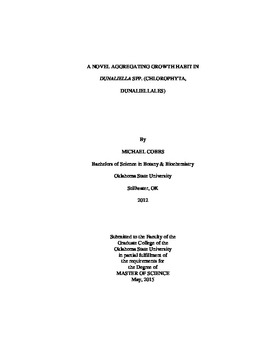| dc.contributor.advisor | Henley, William J. | |
| dc.contributor.author | Cobbs, Michael Edward | |
| dc.date.accessioned | 2016-09-29T18:32:27Z | |
| dc.date.available | 2016-09-29T18:32:27Z | |
| dc.date.issued | 2015-05-01 | |
| dc.identifier.uri | https://hdl.handle.net/11244/45148 | |
| dc.description.abstract | Species of Dunaliella are known to aggregate in a palmelloid stage, but they can also aggregate in a previously uninvestigated manner. This perpetual aggregation occurs in isolates from substrates such as the benthos, supralittoral zone, gypsum crusts, or salt flats, a subset of Dunaliella which has not been sufficiently examined. Two such isolates, GSL-3A4 and GSL-3C2 from Great Salt Lake, Utah, were compared morphologically to the more common single cell habit of isolates GSL-12A4 and GSL-6/1. A method for assessing aggregation efficiency was developed. This work sets the foundation for a new series of discoveries regarding Dunaliella growth habit and desiccation tolerance after 110 years of research with the genus. | |
| dc.format | application/pdf | |
| dc.language | en_US | |
| dc.rights | Copyright is held by the author who has granted the Oklahoma State University Library the non-exclusive right to share this material in its institutional repository. Contact Digital Library Services at lib-dls@okstate.edu or 405-744-9161 for the permission policy on the use, reproduction or distribution of this material. | |
| dc.title | Novel Aggregating Growth Habit in Dunaliella Spp. (Chlorophyta, Dunaliellales) | |
| dc.type | text | |
| dc.contributor.committeeMember | Yang, Ming | |
| dc.contributor.committeeMember | Burnap, Robert L. | |
| osu.filename | Cobbs_okstate_0664M_13938.pdf | |
| osu.accesstype | Open Access | |
| dc.description.department | Botany | |
| dc.type.genre | Thesis | |
